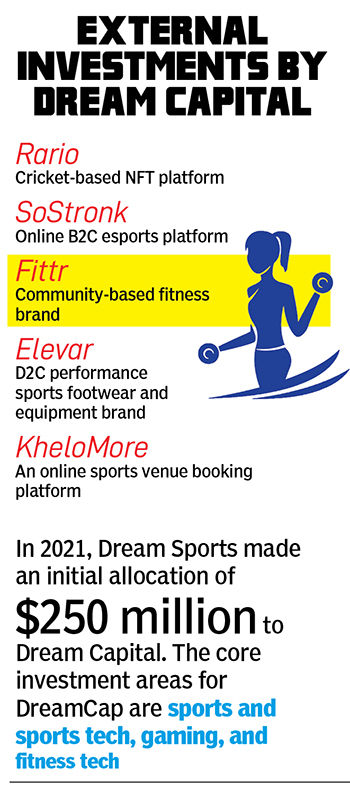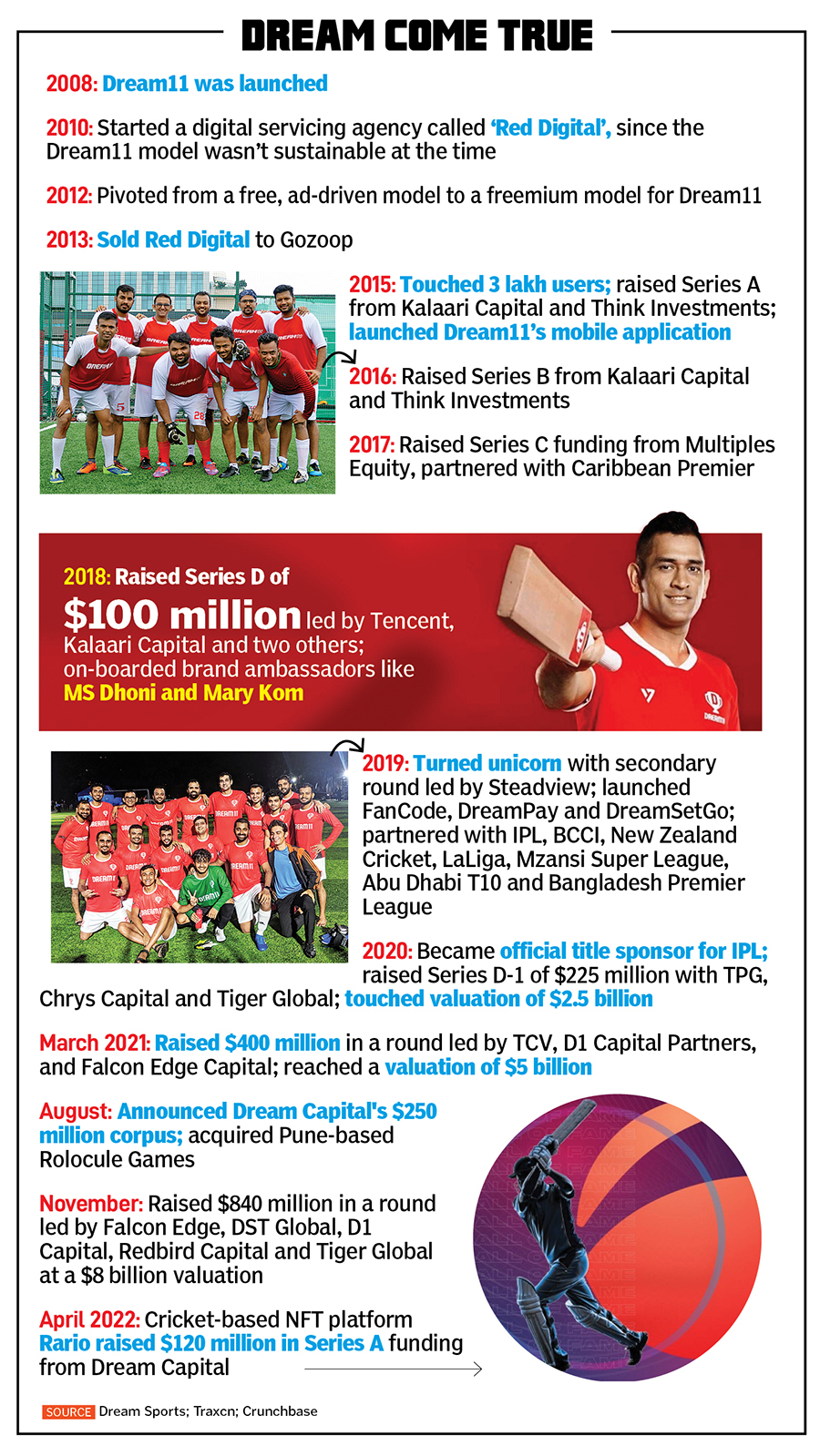Dream Sports started off as a fantasy sports platform, and is now expanding across verticals like sports merchandising and experiential tourism. Will it help the company overcome regulatory hurdles the sector is battling?
Since the 90s, fantasy football has been a rage in the UK. Tabloids like The Sun have run such competitions for years, asking readers to fill in their picks and send across clippings; the newspaper would then announce winners every week. With the advent of the internet in the early 2000s, the game moved online, and a 16-year-old sports buff from Mumbai, who was schooling in London in 2001, was hooked.
Harsh Jain later moved to the US for his undergraduate degree from the University of Pennsylvania, and then returned to India in 2007 to join his family business, Jai Corp. But even as he moved continents, his love for fantasy football remained his constant companion.
In 2008, when the Indian Premier League (IPL) was launched, Jain set out to look for fantasy cricket platforms. He found nothing—the concept was alien to the country even though it loved the game as much as the UK loved football. It was also around the same time that Jain was getting the entrepreneurial itch. “I always wanted to do something on the lines of my three biggest passions—sports, gaming and technology,” he says.
During a casual chat with school friends, the engineering graduate pitched the idea of bringing it all together—creating a fantasy cricket platform. “Let’s launch it ourselves [I thought] if no one else is doing it… even if it’s only for us. If we make a good version, maybe a 100 million other Indians might like it,” he said.
A month later, he finally made up his mind—he was going to go on with it. “Bhavit [Sheth] was the only one to join me. We just jumped in, eyes shut or wide open, however you want to say it,” says Jain. The 22 year olds met a bunch of gaming gurus and, Jain says, “all of them told us it was the worst idea in the world”. Sheth adds, “…they were absolutely right.”
In 2009, when they launched the website, Dream11, it tanked. The model was free to play, advertisement-driven and entailed creating one fantasy team for the full season. “But the problems were manifold. Yes, people love free-to-play, yes, people love to win prizes, but you can only give prizes to the top 5-10 people who play. Second, the ads were coming, but the money wasn’t,” says Jain, the founder of Dream11.
That was then. Today, the fantasy cricket platform claims to have over 150 million users, ahead of rival platforms like Games 24×7 and MPL (Mobile Premier League), which have 100 million and 90 million registered users, respectively. Its parent company, Dream Sports, is valued at a whopping $8 billion and, in 2019, it became the first sports technology unicorn in the country. Dream Sports closed FY21 with a revenue of ₹2,706 crore and a PAT (proft after tax) of ₹329 crore, up from ₹2,120 crore and ₹181 crore, respectively, from the previous year.
Working double shift
But it was hardly smooth-sailing in the beginning. Jain’s family helped him with the seed money for the venture, but, in about a year and a half, Sheth and he ran out of it. “I didn’t want to go back to my family only to say, ‘you were right’,” he tells Forbes India, sitting in a conference room named ‘English Premier League (EPL)’ at ‘The Stadium’ aka Dream Sports’ headquarters in Mumbai’s Lower Parel.
Jain and Sheth were always convinced that online fantasy sports (OFS) will rise to popularity at some point. Their belief has been vindicated recently in a report by Deloitte and the Federation of Indian Fantasy Sports (FIFS) that pegs OFS’s FY21 market size at ₹34,600 crore, and expects it to grow to ₹165,000 crore by FY25.
“But [back then],” says Sheth, “we had to keep the lights on and pay salaries. So we decided to start a servicing business—a digital marketing agency.” They moved most of their staff to the servicing side of the business and had about seven to eight people still working on Dream11.
Given their close ties with IPL team Mumbai Indians (MI), Sheth and Jain managed to onboard them as clients and began handling MI’s Facebook page. In six to nine months, their agency ‘Red Digital’ managed to get a million likes on the team’s page—five times the size of any other team back then. “Back then, every brand wanted to jump onto the social media bandwagon, and would ‘pay per like’,” says Sheth.
Soon, brands like Adidas, Lufthansa, PepsiCo and Monginis were also part of the agency’s clientele. While this was their main revenue-generating business in 2011, Jain says, “If you really pushed us, we would tell you, we have a passion project running on the side called Dream11. Those seven to eight people were keeping that dream alive.”
The duo packed Dream11 with all possible features—from fantasy leagues and live scores to forums and casual games. Over time, they kept improving the product—changed from a per-season to a per-match format, and moved from ad-driven to a freemium model. In 2012, Dream11.com started seeing retention, engagement and monetisation.
“We stripped out everything else but fantasy sports. It was a very hard decision at that time. We built so much stuff—live scores, news, blogs, forums, social networking and games—and we had to trash it. We had close to 50 casual games that we built in-house, each one costing close to ₹10 lakh,” say Jain and Sheth. The duo realised they preferred building products and didn’t enjoy the servicing business as much. In 2013, Red Digital was sold to Gozoop, and the money from the sale was pumped into Dream11.
Keeping the Dream alive
Once they started gaining some traction, Sheth and Jain set out to look for funding, but most venture capital (VC) funds in India would tell them, “This is a foreign concept, India mein fantasy koi nahi samajta hai [No one understands fantasy in India]. Why don’t you do ecommerce?”
From 2012 to 2014, the duo claims to have reached out to 150 VCs in India and the US—where Jain was pursuing his MBA from Columbia University. “When you hear a ‘no’ 150 times, you also learn more about your business each time—from gross margins and contribution margin to the retention curves and total addressable market [TAM],” says Jain. “In one of our early meetings, an investor asked us, ‘What’s your TAM?’ and we were like, ‘Who’s she?’” he laughs.
Soon after Jain’s graduation, he met Vani Kola, founder and managing director of Kalaari Capital, in New York in 2014, at a time the business had hit 300,000 registered users. Kola recalls, “What I saw in Harsh was a founder who was very mature for his age. He had a clear vision of the kind of leader he wanted to be.” Unlike most entrepreneurs who paint a rosy picture, Kola says, “He was very comfortable openly talking about the risks involved in his business. Most entrepreneurs don’t talk about the risks, let alone a game plan to deal with them.”
Kola was convinced, and seven years after starting the business, Dream11 had its Series A. Soon after Kalaari Capital came on board, they started getting several other investors. “VCs have FOMO (fear of missing out)… it’s the biggest driving factor in the industry,” jokes Jain.
Today, heading a company that’s become synonymous with fantasy sports in the country, Jain insists on a simple vision: “Make sports better.” Building on the core of fantasy sports, the group now wants to throw in sports commerce, content and experiential sports into the mix as well.
One of the reasons for Dream11’s growth and competitive lead over rivals is its investment into technology. Two things stand out, if you look around ‘The Stadium’, it’s office. One, it oozes the love and passion its founders and employees have for sports—be it the artificial grass flooring or the signed memorabilia hanging on walls. Two, the large screens with statistics changing every second.
“Right from the beginning, our primary focus was (and always is) to make sure that we had cutting-edge technology to provide an unparalleled product at scale. We have a real-time, immediately consistent transaction problem to solve and we have prepared ourselves to do this for over 10 million concurrent users,” says Amit Sharma, chief technology officer, Dream Sports.
A majority of the company’s investment goes into technology. Dream Sports has grown from a team of 100 to over 850 employees within five years and nearly 80 percent of their hiring is for core productivity functions of tech, product and design. “Our homegrown tech solutions help us evolve and solve newer tech challenges. They address key product-related challenges such as user experience analysis, scale management etc. For instance, Data Highway, our in-house analytics platform, allows us to have more control over data, heightens safety and flexibility, maximises opportunity costs, and helps us scale services,” adds Sharma.
Beyond fantasy sports
Once the startup turned unicorn in 2019 and was just about to turn profitable, says Sheth, “Dream11 decided to go back to solving the problems we were catering to when we started by investing in various applications.” Unlike the earlier days, the founders had a new game plan—they no longer wanted to create a ‘super app’, but wanted to foray into each of these sports-related services through individual verticals.
In the same year, they incubated a personalised sports content and commerce platform—FanCode; launched a one-stop platform for payment functions—DreamPay; and sports travel and experiences platform—DreamSetGo. In 2021, the group acquired Pune-based Rolocule Games and rebranded it Dream Game Studios, in an attempt to tap into the casual games segment.
“There is no awe-inspiring game for cricket, like FIFA for Football or NBA 2K for basketball. We’re hoping to create a game like that,” says Jain. Through Dream Game Studios, the company is looking at gaming in the multiverse, and through its latest investment in cricket-based NFT platform Rario, they are also getting into the NFT (non-fungible token) market.
“Five years down the line, it is likely that fantasy will be our core, but we would like to believe that it will be a much more diversified company,” says Jain.
Regulatory battles
Of the bad patches that Dream11 has had to encounter in its journey, the one that’s still stoking the fire is the regulatory quagmire the company faces over whether its product involves betting and gambling. In August 2021, the Supreme Court upheld Dream11’s fantasy sports format as a ‘game of skill’, by its order dated July 30, 2021, and dismissed an appeal against a decision of the Rajasthan High Court—in the case of Avinash Mehrotra versus The State of Rajasthan & Ors—which stated that Dream11 is not gambling, betting or wagering.
The Supreme Court has now reaffirmed the decisions of three different high courts—Punjab & Haryana High Court (2017), the Bombay High Court (2019) and the Rajasthan High Court (2020)—that nullified laws banning fantasy sports under the pretext of gambling or betting. At present, states, including Assam, Sikkim, Odisha and Andhra Pradesh, have banned fantasy sports. The Google Play Store also has a worldwide policy that doesn’t allow any real money games.
There are strong voices that believe fantasy sports are indeed betting and gambling. Says Sunieta Ojha, advocate-on-record of the Supreme Court, “The medium has changed but the purpose and intent remain the same, which is to exploit people with promises of quick bucks by putting money on an outcome of some uncertain event. As a matter of fact, technology has made sports betting more accessible given the smartphones, internet, low-cost data and payment gateways,” Jain, however, thinks otherwise. “The Supreme Court has called it a ‘game of skill’… this is not a discussion matter anymore. Fantasy sports in our format—the single full-match format—is legal and is not gambling, betting or wagering. It is a game of skill and a genuine business. We’ve been taken to the Supreme Court three times, and we have a three-out-of-three success rate,” he says.
But with the regulatory uncertainty surrounding the online fantasy sports segment, is the group diversifying to hedge the risks? “Yes and no,” says Jain. “Yes, it helps de-risk, but no that’s not why we are doing it. We are just solving the problem for sports fans in India.”
On May 18, news reports say the Group of Ministers (GoM) has unanimously decided to recommend increasing the goods and services tax (GST) on online gaming, casinos and race courses, from the existing 18 percent to 28 percent. GST is currently charged on platform fee, termed as Gross Gaming Revenue (GGR), rather than on the entire emount pooled in for a game. “While the skill-based online gaming platforms should ideally be at 18 percent, even if we were to assume that they may now be taken to 28 percent, the manner of levy of 28 percent will decide whether it is going to be a problem for the industry. If they follow the current practice which platforms follow, it will be a 10 percent increase,” says Rameesh Kailasam, CEO and president, IndiaTech.org. The organisation has recommended that games involving predominance of skill should ideally be taxed at 18 percent on the platform fee as applicable, as higher tax rates will adversely impact the growth of the industry.
There has been some conversation around GST being levied on company toplines. “How can you pay 28 percent of your topline when your margins are between 10 percent and 15 percent?” asks Jain. “That means you’ll kill the whole industry and then it’s game over.” According to Dream Sports, the Indian online gaming industry today pays close to $1 billion of tax, and if it’s on the toplines, it’s likely to drop significantly.
Uncertainty, especially on the regulatory front, is never good for a business. Yet, Vishal Misra, co-founder at ESPNCricinfo, and professor, Columbia University, believes “Harsh and Bhavit can ride out uncertainties better than anyone else”. Misra, who has known Jain since 2013 and has helped in the initial days, recently joined Dream11 as an advisor.
“The company has a fantastic team, a huge lead on their rivals and are cash-flow positive. I know the kind of problems they’ve solved in terms of tech infrastructure and data science aspects… these would take a very long time for their rivals to crack,” he says. “They’ve built a strong moat around their business. They are constantly innovating, which stems from the top. Both Harsh and Bhavit have relentless focus on making users happy.”
As the market leader—with about 80-85 percent market share—Dream Sports was the founding member of the self-regulatory body FIFS, which was formed in 2017. “This [FIFS] was formed to regulate and promote best practices for online fantasy sports,” says Sheth. Additionally, Dream Sports follows certain guidelines: Every time someone joins a contest, they have to self-certify they are above 18, the state they reside in and, if they win money, need to do a KYC with government-issued IDs. “We also have responsible play limits; every time you lose x amount, we will give you notifications asking you to stop,” adds Jain.
The average transaction on Dream11 is ₹37, and a majority of users at least win their money back. According to them, over 99 percent of Dream11 users have never won or lost more than ₹10,000 in their lifetime on the platform. “Fantasy sports is one of the best ways to engage a sports fan and convert them from a passive audience that’s watching their favourite team, to an active fan, who has skin in the game, who will watch way more and engage way more. It is not meant to have lots of money going in and out,” reckons Jain.
The road ahead
A number of startups that aren’t profitable have gone public. Would Dream Sports—a profitable company—be next in line? “We’ll come back to the same point: Whether it’s a new company, business or going public, what’s the problem we’re solving? If it’s to put up our collar and say we’re going public or get a boom in valuation, we’re not interested. Going public is a big responsibility. We are profitable and we don’t need to raise money. There’s no real reason for us to go public right now,” says Jain.
So far, Dream Sports’ only acquisition has been Pune-based gaming company Rolocule Games. Through Dream Capital, they’ve made multiple investments, including in cricket NFT platform Rario, online B2C esports platform SoStronk, community-based fitness brand Fittr, D2C performance sports footwear and equipment brand Elevar, and an online sports venue booking platform KheloMore.
But, as Sheth says, “We’re not investing to get exits. These are strategic investments and almost every single one of our investments will be a path to majority or to acquire the company.”
There are several acquisitions in the pipeline, now that the group is profitable. “We have free cashflows that we would like to invest further. We’ve been waiting for 1.5 years for this madness to end so we can go shopping. That begins now,” smiles Jain. Sports, gaming and fitness tech will be the three areas they will continue focusing on, “We’ll do whatever it takes to make sports better.”





